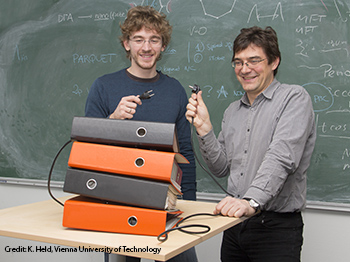
Elias Assmann (left) and Karsten Held demonstrate how their concept for a new type of solar cell is layered like a stack of binders.
A team of researchers at Vienna University of Technology in Austria, along with researchers at Oak Ridge National Lab in the United States and the Universität Würzburg in Germany say that the layering of two absorptive materials, lanthanum-vanadium oxide (LaVO3) and strontium titanate (SrTiO3), are ideally suited for solar cells because their bandgap matches that of the solar spectrum (Phys. Rev. Lett. 110, 078701). The inorganic oxide heterostructure can also be designed with an intrinsic electric field 100 times larger than that found in conventional Si-based solar cells, effectively preventing recombination and improving efficiency.
The structure also inherently provides the thin contacts required to carry away the created electrons and holes.
“The heterostructure naturally has ultrathin contacts,” says coauthor Karsten Held, “in the form of a single layer metallic interface (for the electrons) and surface (for the holes).” This means elimination of the wires that crisscross the face of conventional silicon-based solar cells, which block some of the light collected.
Bulk lanthanum-vanadium oxide, a polycrystalline Mott insulator, features strong absoprtion at approximately 1.1 eV in the middle of the solar spectrum, comparable to that of cadmium telluride, which is widely used in high-efficiency solar cells. In addition to LaVO3| SrTiO3, different combinations of oxide heterostructure materials can be layered to absorb different wavelengths of light at different layers of the solar cell, further improving efficiency.
Colleagues in Würzburg are now working to build and test the new solar cells.
